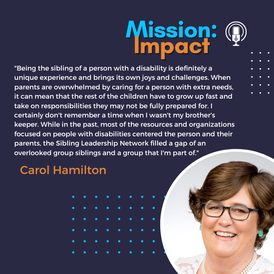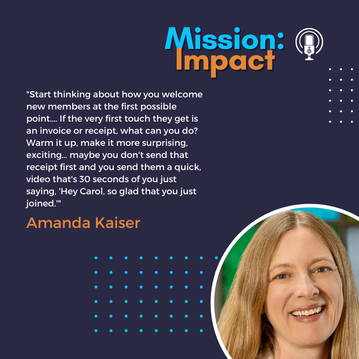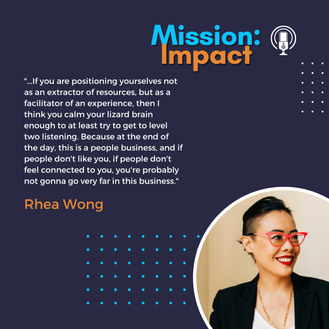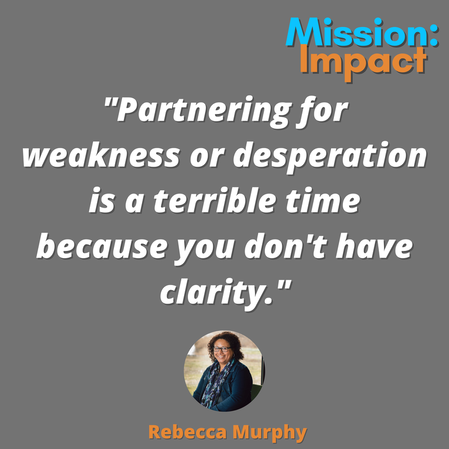Mission: Impact podcast & blog
Build a better world without becoming a martyr to your nonprofit cause
Listen on:
 In episode 80 of Mission: Impact, Carol Hamilton goes solo to celebrate several of the nonprofits that support and enrich her life. Nonprofit organizations play a crucial role in enriching our lives and communities in various ways. Carol discusses:
Important Links:
The Arc of Montgomery County: https://thearcmontgomerycounty.org/ By Their Side: https://www.bytheirside.org/ The Sibling Leadership Network: https://siblingleadership.org/ The Anacostia Watershed Society: https://www.anacostiaws.org/ The Anacostia Riverkeeper: https://www.anacostiariverkeeper.org/ Washington Area Bicyclist Association: https://waba.org/ Click "Read More" for Transcript  In episode 68 of Mission: Impact, Carol and her guest, Amanda Kaiser discuss:
Amanda Kaiser is a member engagement strategist and author of Elevating Engagement: Uncommon Strategies for Creating Thriving Member Communities. As a researcher, author, and co-creator of the Incubator Series and the New Member Engagement Study, she is at the forefront of exploring how member and attendee engagement is rapidly changing within professional communities. Important Links and Resources:
Click "Read More" for Transcript:  In episode 67 of Mission: Impact, Carol and her guest, Rhea Wong discuss:
Rhea helps nonprofits raise more money. Though she has deep experience with institutional, corporate and event fund-raising, she is passionate about major individual donors and helping organizations to establish individual giving programs. She has raised millions of dollars in private philanthropy and is passionate about building the next generation of fundraising leaders. She has become a leader in the New York nonprofit community and is a frequent educational commentator in the media. She has been recognized with the SmartCEO Brava Award in 2015 and NY Nonprofit Media’s 40 under 40 in 2017. Rhea lives in Brooklyn with her husband. When she is not raising money for causes she loves, she can be found hosting her podcast, Nonprofit Lowdown, promoting her newest book Get that Money, Honey! or onstage as a newbie stand-up comedian in downtown Brooklyn. Important Links and Resources:
Click "Read More" for Transcript:  In episode 25 of Mission: Impact, some of the topics that Carol and her guest, Kristin Bradley-Bull discussed include:
Kristin Bradley-Bull’s tagline says it all: “Illuminating your vision. Extending your vast roots and branches to get there.” She runs Roots to Canopy in Durham, NC. At Roots to Canopy, Kristin consults with non-profits to develop powerful strategies and plans – and to develop staff capacity to be wildly successful in making change in the world. She does the same in her coaching practice: supporting people to crystalize their vision and orient toward their North Star – as non-profit leaders and as humans. Kristin loves people, justice, organizations and movements, and transformation on all levels. Her background includes co-founding a training and leadership non-profit, being a full-time public health faculty member, and consulting (20 years+) with organizations ranging from multilaterals to grassroots social justice groups. Important Guest Links: The book mentioned during the show is Forces for Good: The Six Practices of High-Impact Nonprofits by Leslie R. Crutchfield and Heather McLeod Grant Information on the size of the nonprofit sector in the US: https://nccs.urban.org/publication/nonprofit-sector-brief-2019#the-nonprofit-sector-in-brief-2019 Divorcing White Supremacy Culture website http://www.whitesupremacyculture.info/ Click "Read More" for Transcript:  This week we’re talking to Rebecca Murphy. We talked about:
Rebecca has been a consultant for over 20 years. She considers herself an “interpreter,” as she has worked in multiple sectors including government, nonprofit, business, and philanthropy. She is adept at explaining/translating one to another. She is a generalist with a broad knowledge base – including workforce development, affordable housing, parks and place making. She has expertise in capacity building, organizational and program development, strategic planning, with particular expertise in public-private partnerships, community engagement, and strategic collaborations. Hers is a mission-focused practice. She is passionate about mission fidelity, and avoiding mission creep. Links: https://rcmstrategicconsulting.com/ https://twitter.com/RCMStratConsult Click "Read More" for Transcript: |
Archives
April 2024

Grace Social Sector Consulting, LLC, owns the copyright in and to all content in and transcripts of the Mission: Impact podcast, as well as the Mission: Impact blog with all rights reserved, including right of publicity.
|
Telephone301-857-9335
|
info[at]gracesocialsector.com
|
Grace Social Sector Consulting, LLC, owns the copyright in and to all content in, including transcripts and audio of the Mission: Impact podcast and all content on this website, with all rights reserved, including right of publicity.
|